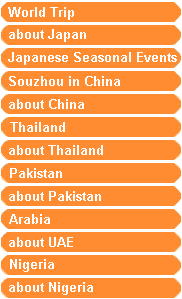|
Japanese Seasonal Events
We have beautiful four seasons. Japanese enjoy the change of four seasons such as
cherry blossom view in spring, the moon view in autumn and snow scene view in
winter. it is very important to know about nature in Japan in understanding
Japanese customs and culture.
New Year's Day
New Year's Day called Ganjitsu is to celebrate the beginning of the New Year and
welcome the god of the year home.
Bean Throwing
In February, we have Setsubun, which means the devision of the seasons. It means
the day before the first setting-in each season. Winter changes into spring on this
day. Bean throwing is a traditional celemony to throw beans inside and outside homes
while shouting Huku-wa-uchi (fortune in) Oni-wa-soto (devils out). Bean is mame
in Japanese which means health. If people ate same number of beans as their age,
they would be healthy.
 Girl's or Doll's Festival
Girl's or Doll's Festival
We have the Hina-Matsuri (Girl's Festival or Doll's Festival) celebrated with the
display of hina dolls on March 3. It is also called Momo-no-sekku (Peach Festival).
Cherry Blossom View
Talking of flower in Japan, it is definitely cherry blossoms. People have a good time
under the cherry trees while eating, drinking and singing.
 Boy's Festival
Boy's Festival
We have Boy's Festival called Tango-no-sekku on May 5. Gogatsu-ningyou, warrior
dolls in armor is displayed. You can also see the carp-shaped streamers displayed
on the top of the tall pole in the gardens. The carp is the symbol of strength and
courage.
Plum Rain
We have a rainy season called Baiu or Tsuyu in June. Rain goes on day after day.
Baiu is put into English as plum rain, because Japanese plum ripens around the time.
Rain is very important for farmers to plant rice.
Star Festival
In July 7 night, we have the Star Festival called Tanabata. Vega and Altair (the
Weaver Star and the Cowherd Star) are able to meet accross the Milky Way once
a year on the night. We put decorations with pieces of colored paper written wishes
and poem on bamboo branches.
Bon
We have the Bon in the middle of August. People welcome the ancestral sprits who
return to their homes during the Bon and console them.
Moon-viewing
In September, we have the moon-viewing event called Tsukimi, because the full
moon brights at night. It is our custom to offer seasonal fruits, vegitables
and rice ball called dango with pampas grass called Susuki to the full moon.
Shichi-go-san
We have the Shichi-go-san in November 15 which literally means 7-5-3. People take
children of seven (girls), five (boys) and three (boys and girls) to the shrine
to pray their growth and health.
|

